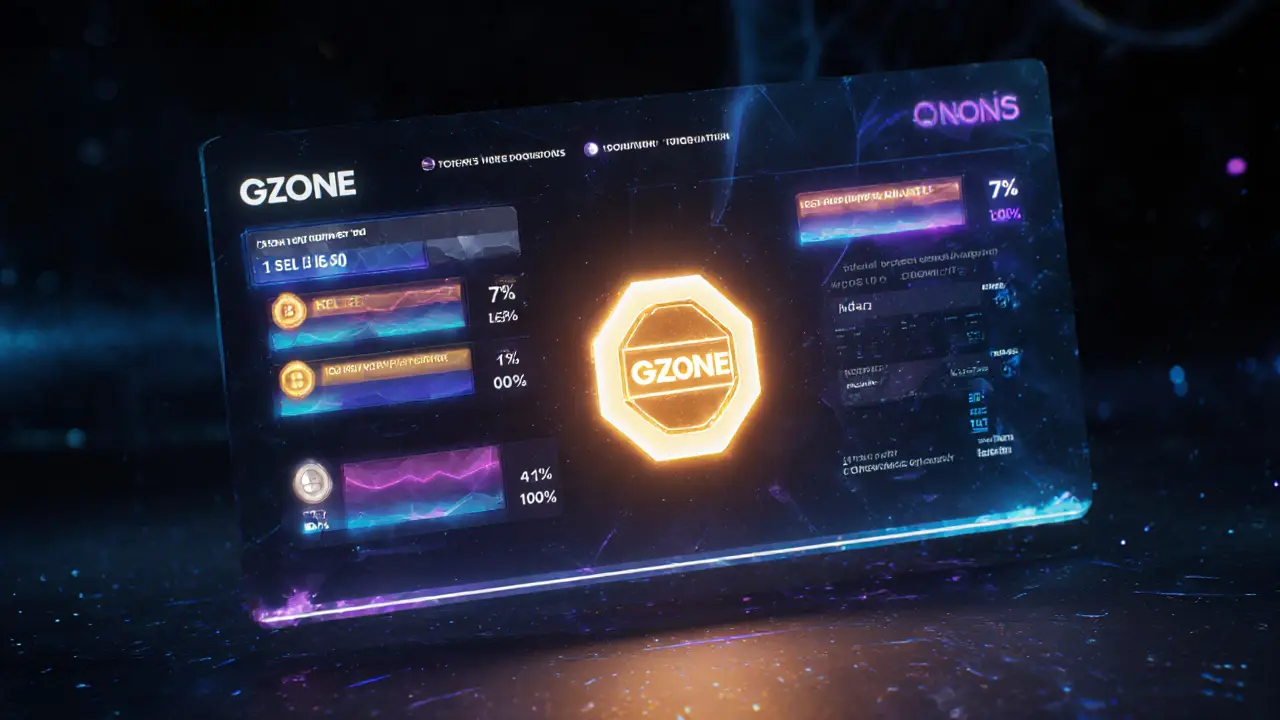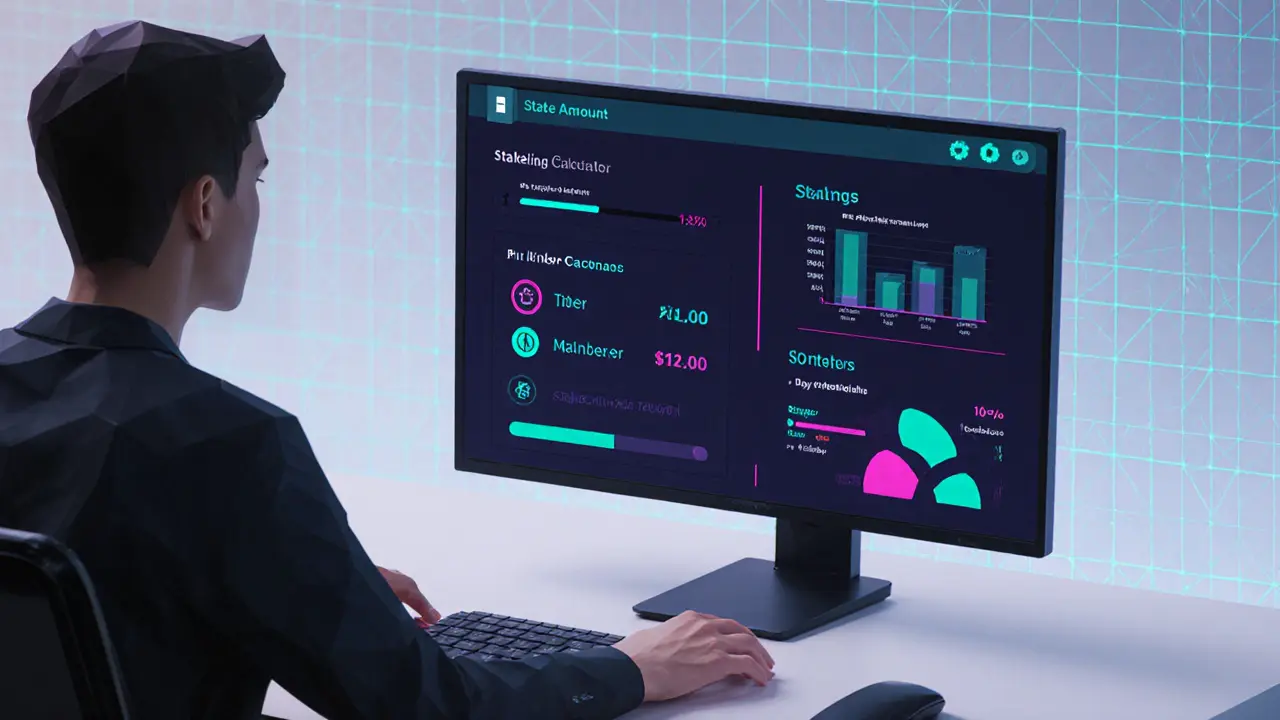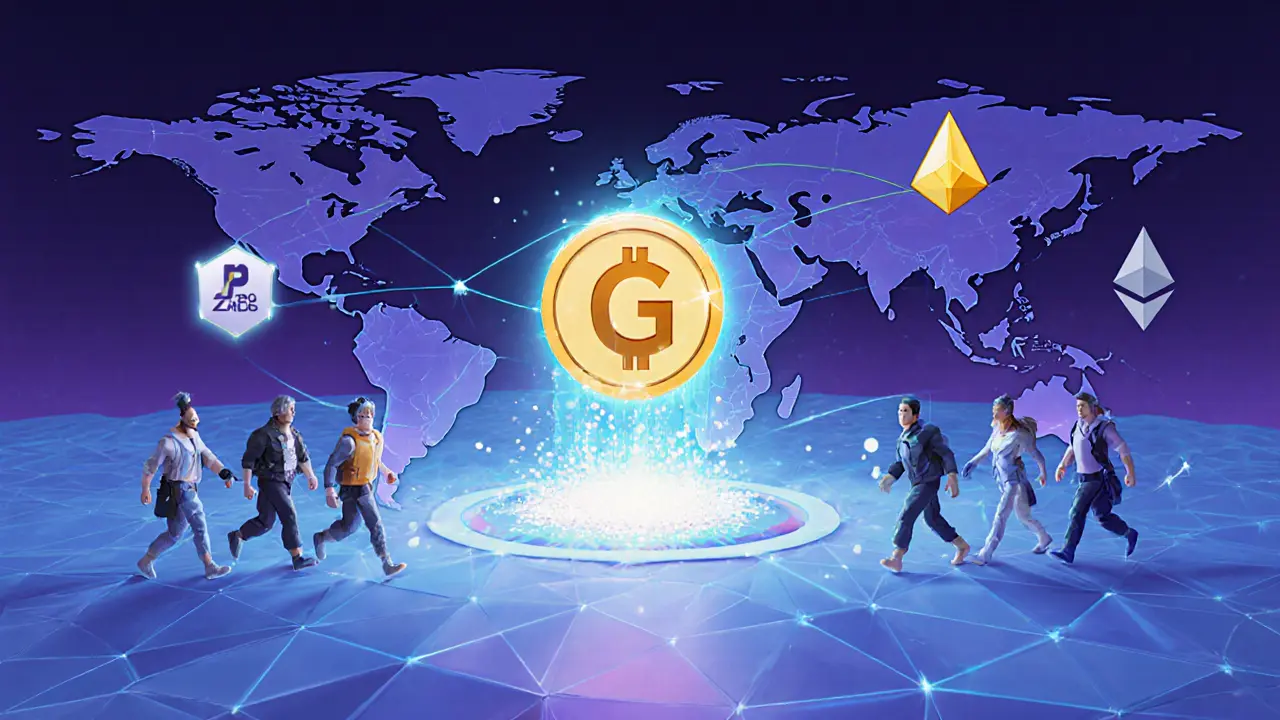GameZone GZONE IDO Launch & Airdrop Details - Full 2025 Guide

GameZone GZONE Token Airdrop Calculator
Tokenomics Overview
- Token Supply 1 Billion GZONE
- Sell Fee 7%
- Burn Portion 2%
- Reward Pool 5%
Staking Tiers
Staking Calculator
Your Estimated Airdrop Rewards
Daily Reward Estimate:
$0.00
Based on current 5% fee pool distribution
Monthly Reward Estimate:
$0.00
Assuming 30-day month
How It Works:
Each sell transaction generates a 5% reward pool. Your share is proportional to your staked amount and tier multiplier.
With your stake of 10,000 GZONE at Silver, you'll earn of the daily rewards.
⚠️ Remember: Rewards are credited daily and can be claimed anytime, but early unstaking incurs a 25% penalty.
TL;DR
- GameZone’s dual‑phase IDO raised $1.22million in September2021.
- The GZONE token uses a 7% sell fee - 2% burns, 5% staking rewards (continuous airdrop).
- Four staking tiers determine allocation weight for new GameFi projects.
- Current circulating supply is ~421.55MGZONE; price sits around $0.00274 (Oct2025).
- To earn rewards, stake GZONE on the official platform and avoid the 25% early‑unstake penalty.
What is GameZone and why does its IDO matter?
GameZone is a blockchain gaming launchpad that connects developers with retail gamers through Initial Game Offerings (IGOs) and Initial NFT Offerings (INOs). Launched in 2021 under the BlueZilla incubator and accelerator for crypto startups ecosystem, GameZone aims to democratize access to GameFi projects that were previously dominated by whales and VC funds.
The platform runs on multiple chains - Polygon, Binance Smart Chain, Solana and Ethereum - giving projects flexibility to pick the most cost‑effective network. By aggregating talent, funding, and communitysupport, GameZone has become a go‑to launchpad for titles like Katana Inu, Galactic Quadrant and Velhalla.
GZONE token basics and the GameZone GZONE IDO
The native utility token, GZONE a deflationary BEP‑20/ERC‑20 token with a capped supply of 1billion, powers every feature on the platform. Its IDO was split into three phases:
| Phase | Amount Raised | Key Participants |
|---|---|---|
| Private Sale | $110,000 | Strategic investors & early backers |
| Public IDO | $112,500 | Retail community via staking tiers |
| Strategic Round | $1,000,000 | BlueZilla & partner funds |
All three phases together supplied $1.22million of capital, giving the platform the runway to build its incubator, marketplace and multi‑chain infrastructure.
Deflationary tokenomics - the built‑in airdrop mechanism
The token employs a 7% fee on every sell transaction. The fee is split as follows:
- 2% sent to an automatic burn address, reducing total supply.
- 5% routed to the staking rewards pool distributed proportionally to all active GZONE stakers. This continuous distribution works like an on‑chain airdrop for anyone who keeps tokens staked.
Early unstaking carries a penalty that can rise to 25%, discouraging short‑term flips and strengthening the token’s price floor during bear periods.

Tier‑based allocation system - how staking unlocks launchpad spots
GameZone’s core participation model hinges on four staking tiers. The more GZONE you lock, the higher your "pool weight" and the better your chances to grab allocation in sought‑after IGOs.
| Tier | Minimum Staked GZONE | Pool Weight Boost | Extra Perks |
|---|---|---|---|
| Bronze | 5,000 | 1× | Basic IGO access |
| Silver | 25,000 | 1.5× | Early‑bird whitelist slots |
| Gold | 100,000 | 2× | Reduced marketplace fees |
| Platinum | 500,000 | 3× | VIP support & exclusive token sales |
Stakers also earn the 5% fee‑derived rewards, effectively receiving a perpetual airdrop while they stay in the system.
Current market snapshot (Oct2025)
As of the latest on‑chain data, the circulating supply stands at421,550,084GZONE, with a market cap of roughly$1.16million. The token trades around$0.00274, far below its all‑time high of $1.18 in November2021.
Technical indicators paint a bearish picture: 14‑Day RSI is 15.56 (oversold), 30‑day volatility sits at 13.21%, and the 50‑day SMA ($0.01206) sits well above the current price. The Fear & Greed Index reads 26 (Fear), suggesting that sentiment is currently negative but could set the stage for a rebound if the broader crypto market stabilizes.
Price forecasts from independent analysts (crypto.ro) anticipate a potential upside to $1.43 average in 2025 and $2.50 by 2026, driven by increased adoption of GameFi and new partnership announcements. However, those outlooks assume a favorable macro environment and successful rollout of upcoming GameZone‑incubated titles.
Step‑by‑step: How to earn the built‑in airdrop
- Visit the official GameZone website and connect a supported wallet (MetaMask, Trust Wallet, etc.).
- Navigate to the “Staking” dashboard - the page is marked with the GZONE token icon.
- Select the amount of GZONE you wish to lock and choose a tier (Bronze‑Platinum). Confirm the transaction (gas fees apply based on the chosen network, e.g., Polygon for lowest cost).
- Once staked, you’ll automatically start earning a share of the 5% fee pool. Rewards are credited daily and can be claimed any time, but avoid early‑unstake penalties by staying locked for at least 30days.
- Monitor the “Airdrop” tab for any partner‑project distributions that may be airdropped straight to your staking rewards balance.
Remember, the only way to truly capture the airdrop‑like rewards is to keep your tokens in the staking contract; withdrawing early not only forfeits a portion of rewards but also triggers the 25% penalty.
Risks and considerations
- Market volatility: GZONE price has dropped >95% from its peak. Holding during deep dips can erode portfolio value.
- Liquidity: Most GZONE trading occurs on low‑volume DEXs. Large sell orders can cause slippage.
- Regulatory exposure: GameFi projects face increasing scrutiny in several jurisdictions; future compliance requirements could affect token utility.
- Unstaking penalty: The 25% fee is dynamic and may increase during high‑stress periods, so plan exits carefully.
- Platform risk: While BlueZilla adds credibility, a single point of failure in the launchpad’s smart contracts could affect all stakers.
Future outlook - why the IDO and airdrop still matter
GameZone isn’t just a token launch; it’s a full‑stack incubator. Upcoming projects slated for Q42025 include a Play‑to‑Earn RPG on Solana and an NFT‑based metaverse marketplace on Polygon. Each new launch injects fresh demand for GZONE staking, which in turn fuels the fee‑derived airdrop pool.
If the platform successfully scales its marketplace and keeps delivering high‑quality games, the token’s utility could rise faster than price speculation alone, creating a virtuous cycle for long‑term holders.

Frequently Asked Questions
What is the difference between the IDO phases?
The private sale targeted strategic investors at a discounted price; the public IDO opened allocation to anyone who met the staking‑tier requirements; the final strategic round brought in BlueZilla’s capital and partner funds to ensure long‑term runway.
How are staking rewards calculated?
Every sell transaction creates a 5% reward pool. The pool is divided proportionally among all staked GZONE based on each holder’s share of the total staked supply. Rewards accrue daily and can be claimed at any time.
Can I unstake without penalty?
Yes, but only after the minimum lock‑up period (usually 30days). Early withdrawal before that period triggers a penalty that ramps up to 25% of the withdrawn amount.
Is the airdrop a one‑time event?
The token’s fee‑based reward system distributes tokens continuously, effectively acting as an ongoing airdrop. Occasionally, partner projects also drop extra tokens directly to stakers.
What chains does GameZone support?
GameZone operates on Polygon, Binance Smart Chain, Solana and Ethereum. Users can stake GZONE on any of these networks, though Polygon usually offers the cheapest gas fees.

april harper
May 4, 2025 AT 12:26Ah, the seductive allure of tokenomics, a modern ode to speculative faith; we stand at the precipice of another airdrop, wondering if the wind will ever carry our hopes. The GZONE mechanics whisper promises of tiered glory, yet the fine print suggests a gentle nudge toward perpetual staking. One could argue that the 5% reward pool is a polite smile in a crowded ballroom of DeFi projects. Still, the lazy observer might simply scroll past, letting the dream dissolve in a fleeting sigh. In any case, the dance continues, and we, the reluctant spectators, keep watching.
Kate Nicholls
May 12, 2025 AT 15:06The tier system looks clean on paper, but the real test will be liquidity when the sell fee is applied. Bronze stakers may feel left out while the higher tiers sip from a richer pool. It’s a classic carrot‑and‑stick scenario that could either boost long‑term commitment or push newcomers away. Overall, the structure feels purposeful, though execution will decide its fate.
VICKIE MALBRUE
May 20, 2025 AT 17:46Nice layout! Simple and clear.
Jason Brittin
May 28, 2025 AT 20:26Looks like they’ve packed the whole guide into a single page – love the minimalist vibe 😎. The calculator even pretends to be your financial advisor, which is adorable. Remember, 25% early‑unstake penalty is basically a “don’t be greedy” badge. Stay chill, stake smart, and maybe the airdrop will actually land somewhere besides the hype train. 🚀
Ben Dwyer
June 5, 2025 AT 23:06Good point about the penalty, it’s essential to factor that into any staking strategy. Planning your exit well in advance can save a lot of tokens. Keep an eye on the fee pool trends, they’ll give you a better sense of potential rewards. Patience and disciplined staking often outperform chasing quick gains.
Kate Roberge
June 14, 2025 AT 01:46Honestly, the whole “early‑unstake penalty” feels like a gimmick to lock users in, not a genuine incentive. If the project truly believed in its tokenomics, it would let people exit freely and let market forces speak. This forced loyalty rarely ends well for the community. It’s a red flag that the team is more interested in retaining capital than delivering value.
Rajini N
June 22, 2025 AT 04:26The GZONE tokenomics allocate 5% of each sell to the reward pool, which is then distributed proportionally based on staking amount and tier multiplier. For example, a user staking 10,000 GZONE at the Silver tier (1.5× multiplier) will receive a share calculated as (10,000 × 1.5) divided by the total weighted stake of all participants. This share determines the daily reward payout from the accumulated pool. Monitoring the total weighted stake is crucial; as more users join higher tiers, your relative portion diminishes.
Oreoluwa Towoju
June 30, 2025 AT 07:06Tier multipliers boost rewards, but they also raise the entry barrier for larger payouts.
Amie Wilensky
July 8, 2025 AT 09:46Wow!!! This guide is… well… it’s… a fascinating blend of clarity & chaos!!!; the use of bold headings draws the eye, yet the sheer volume of numbers can overwhelm the casual reader!!!; still, the step‑by‑step calculator is a lifesaver for those who love digging into details!!!
Katrinka Scribner
July 16, 2025 AT 12:26I love the vibe of this guide-it's super helpful!! The only thing i wish they added is a quick FAQ about the unstake penalty. Otherwies, good job!! 😅
Clint Barnett
July 24, 2025 AT 15:06Embarking on the GZONE staking journey feels akin to setting sail on a vessel whose sails are woven from both ambition and speculative optimism, each gust of market activity inflating the canvas in unpredictable ways. The tiered multiplier system, ranging from a humble bronze to a lofty platinum, serves as a nuanced mechanism that rewards deeper pockets while simultaneously encouraging broader participation across the community. One must appreciate the elegance of a 5% reward pool, cleverly siphoned from every sell transaction, as it creates a self‑sustaining ecosystem where activity begets reward, fostering a virtuous cycle of engagement. However, the 25% early‑unstake penalty looms like a shadow, reminding participants that patience is not merely a virtue but a fiscal necessity within this architecture. To truly grasp the potential yields, a diligent investor should first calculate their weighted stake-multiplying the raw GZONE amount by the tier’s specific multiplier-and then compare that figure against the aggregate weighted stake of the entire network. This comparative analysis reveals the proportion of the daily reward pool one can anticipate, translating abstract percentages into concrete token figures. Moreover, the daily reward estimate displayed in the guide, while illustrative, must be contextualized against real‑world market volatility, which can cause the underlying token price to swing dramatically, thereby affecting the fiat value of the rewards. It is also prudent to monitor the total token supply in circulation, as excessive staking can lead to liquidity constraints, potentially impacting tradeability on decentralized exchanges. The interplay between staking, token supply, and fee distribution creates a delicate balance that the protocol’s governance must vigilantly maintain. As the community grows, the relative share of each staker naturally dilutes, prompting savvy participants to either increase their stake, ascend to a higher tier, or strategize around periods of lower network activity to maximize returns. In addition, the guide’s calculator, though user‑friendly, should be complemented with external analytics tools that track fee pool accumulation in real time, providing a more granular view of the reward dynamics. Transparency in these metrics not only builds trust but also empowers users to make data‑driven decisions rather than relying on optimistic projections alone. Furthermore, the psychological aspect of locking funds for extended periods cannot be ignored; the fear of missing out on alternative opportunities may weigh heavily on risk‑averse investors. Hence, incorporating flexible staking options or partial unlocks could enhance the protocol’s appeal without compromising its economic model. Ultimately, the GZONE airdrop and staking framework present a compelling proposition, provided participants approach it with calculated diligence, continuous monitoring, and a willingness to adapt to the evolving DeFi landscape.
Carl Robertson
August 1, 2025 AT 17:46Oh, the suspense! Just when you think the airdrop is a myth, they drop this glossy guide, teasing us with Tier‑based riches. It reads like a thriller where every line could be the next plot twist that either makes us millionaires or leaves us watching the dust settle. The drama is real, folks.
Waynne Kilian
August 9, 2025 AT 20:26While the excitement is palpable, it’s worth remembering that each participant’s experience will differ, and constructive dialogue can help us all navigate the intricacies of the reward system. Let’s keep the conversation respectful and share insights openly.
Naomi Snelling
August 17, 2025 AT 23:06Did anyone notice that the 7% sell fee conveniently aligns with the seven‑day week, just enough time for the team to funnel the pool into off‑chain wallets before we even realize it? Coincidence? I think not.
Michael Wilkinson
August 26, 2025 AT 01:46Stop feeding the paranoia and look at the numbers; the fee structure is transparent, and the pool distribution follows the code. Your fearmongering does nothing but scare away potential stakers.
Billy Krzemien
September 3, 2025 AT 04:26Great point about the transparency. Clear on‑chain metrics are essential for trust, and the community can use block explorers to verify fee allocations. Maintaining open dialogue will keep the ecosystem healthy.
Jacob Anderson
September 11, 2025 AT 07:06Oh joy, another tiered airdrop – just what the crypto world needed.
MD Razu
September 19, 2025 AT 09:46The irony of praising a “fair” distribution while simultaneously imposing a hefty early‑unstake penalty is not lost on seasoned observers; it reflects a deeper tension between incentivizing commitment and restricting liquidity, a balance that many projects fail to master. By embedding such a penalty, the architects of GZONE ostensibly aim to curb speculative churn, yet this very mechanism may deter the very participants whose long‑term engagement they seek. Moreover, the tier multipliers, while mathematically elegant, create a stratified hierarchy that could exacerbate wealth concentration among early adopters, thereby undermining the egalitarian ethos that many DeFi initiatives champion. Consequently, prospective stakers must weigh the allure of higher multipliers against the risk of being locked into a potentially volatile token economy, especially when market sentiment can shift dramatically in short order. In essence, the decision to stake should be informed not just by the projected reward percentages but also by an appraisal of the broader strategic architecture, including the impact of penalties, tier dynamics, and market volatility.
Charles Banks Jr.
September 27, 2025 AT 12:26Sure, because adding more sarcasm to a crypto guide always makes it more trustworthy.
Lindsay Miller
October 5, 2025 AT 12:26Staking can be rewarding if you understand the mechanics.